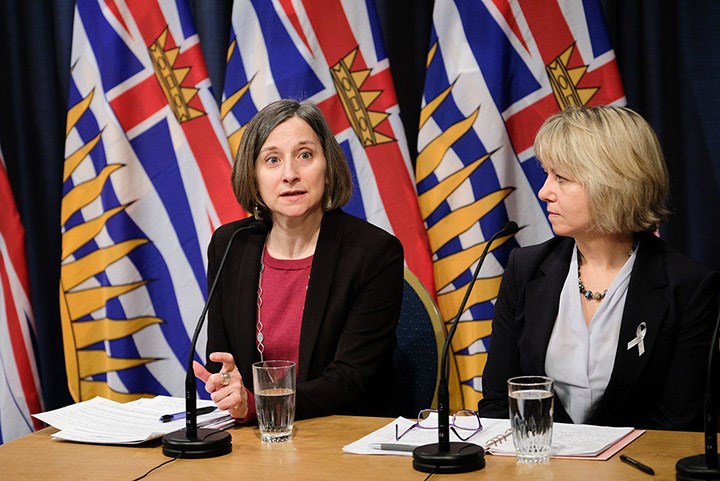Last year, for the first time, Northern BC earned the tragic distinction of having the highest rate of illicit drug deaths in the province, and experts cited rural isolation, stigma, a toxic drug supply and inadequate treatment services as causes.
While it's tough to pinpoint the exact causes in a given community, there are certain factors that stand out, B.C.’s Chief Coroner Lisa Lapointe said.
“It is often a consequence of services,” Lapointe said. “What is available in terms of supports for people who are experiencing problematic substances? Are there overdose prevention sites available? Is naloxone widely available?”
Of the 32 overdose prevention and supervised consumption sites in the province, only one is located in Northern Health.
The lone overdose prevention site in Prince George helps people with addictions and other health issues, and in 2020, got 3,583 visits from January to November of 2020, according the BC Centre for Disease Control (BCCDC).
By comparison, six sites in Interior Health received 4,902 visits during the same time frame.
“Harm reduction measures are a key part to keep people alive, but so is access to safe supply so we're not forcing people to go to the illicit, for-profit drug market,” said Lapointe.
COVID-19 disrupted the illicit drug supply and local drug makers have filled the gap with a variety of toxic alternatives. From 2017 to 2020, illicit fentanyl, 50 times or more stronger than heroin, was found in nearly 87 per cent of the overdose deaths. Cocaine and methamphetamine were second most prevalent.
People are at the whim of an unpredictable, unregulated market, said Lapointe.
To provide safe supply, 10 Opioid Agonist Treatment (OAT) clinics in Northern Health offer a range of services including prescribed medications to manage cravings or ease opioid withdrawal, and access to naloxone, which can reverse an opioid overdose. Some health practitioners also prescribe OAT medications which help support people to engage in recovery.
“When people are stabilized and looking for recovery and treatment options, those need to be available,” said Lapointe, adding that treatment also needs to be financially and geographically accessible in communities with the biggest “burden of overdose.”
“There's a lack of resources, a lack of supports for people who are wanting to get assistance or help,” said Maureen Davis, executive director of the northern BC chapter of the Canadian Mental Health Association. “There's always extensive wait periods.”
Last week, the provincial government announced funding for 100 new treatment beds in the province, including 12 in Kamloops. None were located in Prince George or the Robson Valley area.
“Systemically, we're not set up really well for treatment,” Davis said, who has worked on the mental health front lines in Prince George for 30 years. “We really don't have treatment centers here, so you're waiting to be sent somewhere, and lots of times people fall apart.”
In 2020, 1,716 British Columbians died from an illicit drug overdose, including 132 people in Northern Health, which equalled 46 deaths per 100,000 population, the highest in B.C. The provincial rate was 33 per 100,000.
Living in the north is just harder, she said Davis. “And COVID is making all the isolation that is often a part of living in northern and rural communities, and (worsening) it even more.”
From 2018 through 2020, Prince George (including the Robson Valley) lost 142 people to illicit drug overdoses; 144 people from Kamloops died, and five people from North Thompson, including Clearwater, Vavenby, and Blue River, lost their lives.
“What's most worrying to me is that we're a year into COVID and we're still seeing such high numbers all across B.C.,” said Dr. Rakel Kling, northern interior medical officer for Northern Health.
“It can happen to anyone, in any age group, in any family, in any community,” said Kling, and the pandemic has increased the risks. “People are using drugs alone and overdosing alone.”
Discrimination is another factor in overdoses, Kling said. “Everywhere in all of our communities, stigma is a huge problem. There's a lot of unwillingness to have support available for people who use drugs or have them located in certain areas.”
Some communities have taken a stigmatizing, almost a shame-based, approach, Lapointe said. “In those situations, people are fearful of coming forward, they don't want to divulge their drug use, they're fearful of losing their jobs, of the shame associated with it.”
It’s difficult to know the scope of the problem, said Dannielle Alan, Robson Valley-Canoe director for the Regional District of Fraser-Fort George. “Here, it's very much under the radar.”
Some people may leave the community for drugs or treatment since both are more accessible in larger cities, she said. Alan thinks McBride should host a treatment facility.
“Across British Columbia, we don’t have the services people need,” Alan said. “Rather than put them in the middle of a city where they're surrounded by the same lifestyle, take them out of that completely put them in a healthy (mountain) environment.”



